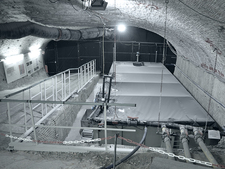Asse influent brine: BfS considers requirements for the facility’s further operation in the long term

![]() Main collecting point of influent brine on the 658-m level
Main collecting point of influent brine on the 658-m level
For the long-term and safe operation of the mine it is imperative to remove the radiologically uncontaminated brine continuously flowing into the Asse mine. For this purpose, the Federal Office for Radiation Protection (BfS) is examining and considering several environmentally friendly variants.
So far, the brine has been taken to the former Mariaglück mine near Celle. One out of several further options is to use already existing discharge points for brine. The BfS maintains such a facility at the former Gorleben exploratory mine on the river Elbe. At present, the brine volumes from the Asse to be disposed of consist of 10 to 11 cubic metres per day; that corresponds to a volume of about 25 bath tubs.
Application filed at the Land Mining Authority
The BfS filed an application for the disposal of radiologically uncontaminated brine from this discharge point in the Asse – the volume being strictly limited – to the competent licensing authority, the Landesamt für Bergbau, Energie und Geologie (LBEG) of the Federal State of Lower Saxony. A meeting was held with representatives of the administrative district of Lüchow-Dannenberg to discuss this application. The competent authorities, the State Mining Authority and the Water Protection Authority of the administrative district, will examine as to whether the project will comply with all requirements under water and nature conservation law and whether to grant a licence. In this context, strict environmental standards have to be fulfilled to exclude negative environmental impacts.
Use of the discharge point already existing near Gorleben
For several years, the BfS has had a permit to discharge brine into the river Elbe near Gorleben. This brine consists of rainwater that has dissolved salt from the heap located in the area. The salt heap was already produced years ago when the Gorleben salt dome was being explored. It exists irrespective of the renaturisation of the exploratory mine that has been agreed between the federal government and the Land. This will not change because of the additional usage for the Asse brine, either.
The permit for the discharge near Gorleben comprises maximum 56,300 cubic metres of brine per year. The discharge has been limited to this volume in order to avoid an increase in the salt content of the water as a result of environmental damage. Also in the event of Asse brine being discharged there, the approved volume is not to increase.
One to five million: The Asse brine in proportion to the river Elbe
The brine volume accruing inside the Asse mine and being removed within one year, is currently about 4,000 cubic metres. To illustrate the volume, the BfS has converted it into bathtubs. This results in about 25 filled bathtubs per day. In the administrative district of Lüchow-Dannenberg, however, about 129 million bathtubs of water from the river Elbe go downstream in one day. The proportion from Asse brine to the volume of water in the river Elbe is about one to five million.
Asse brine of no radiological concern
Daily, about 12 cubic metres of brine flow into the Asse mine. The major part of this, between 10 and 11 cubic metres per day, is collected by the BfS above the emplacement chambers containing the radioactive wastes. The liquids do thus not come into contact with the wastes stored in the Asse mine and are radiologically uncontaminated. Regular measurements help provide evidence that the water is of no radiological concern. The values measured, eg. for the radioactive material tritium, fall below the limit values for drinking water by the twentyfold. The measurement results (in German) can be downloaded on the internet.
Removal of brine is a licensing requirement for the Asse mine operation
The brine must be removed on a regular basis in order to ensure the facility’s ongoing operation. The proof as to where to take the brine is thus also a licensing requirement for the further operation of the Asse mine.
For some years, the Asse influent brine has been taken to a former mine near Celle. The abandoned Mariaglück mine is being flooded with the brine from various deliverers. This is a normal procedure for former winning mine. The contract with the mine operator ends on 31 December 2016, since the mine’s capacity is limited. The BfS is thus examining different options as to how the uncontaminated brine can be disposed of in an environmentally friendly manner. The discharge of the brine into the river Elbe is one out of several variants that are possible and currently examined in parallel.

